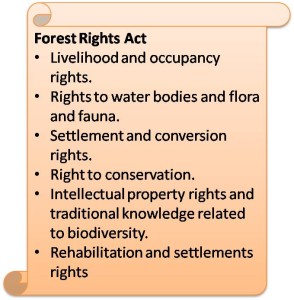Forest Rights Act of India, Part 1
(This is a continuing series of articles on the Forest Rights Act. This is the first part of the series.)
 Introduction
Introduction
The Scheduled Tribes and Other Traditional Forest Dwellers (Recognition of Forest Rights) Act, 2006 is unique in being a legislation that guarantees traditional local communities, the right over forest land on which they have been dependent since ancient times. The notification of Rules for the implementation of the Forest Rights Act, 2006 came on 1st Jan 2008.
SIGNIFICANCE OF THE ACT
For the first time Forest Rights Act recognizes and secures-
- Livelihood and occupancy for individuals and communities for ST’s and Other Traditional Forest Dwellers. It recognizes the right of ownership and also to use and collect minor forest produce.
- Also, the rights such as rights to water bodies and flora and fauna.
- Settlement and conversion of all forest villages into revenue villages.
- Right to protect, regenerate, or conserve or manage any community forest resource, which they have been traditionally protecting and conserving for sustainable use.
- Intellectual property rights and traditional knowledge related to biodiversity.
- Rehabilitation and settlements rights including the provision to get alternate land in cases of displacements or evictions.
Since times immemorial, the tribal communities of India have had an integral and close knit relationship with the forests and have been dependent on the forests for livelihoods and existence. The relationship was mutually beneficial and not one sided. However, rights were rarely recognized by the authorities and in the absence of real ownership of the land, the already marginalized local dwellers suffered. Even the Forest Conservation Act did not correct it and sought to further dissociate the tribals from their traditional linkages to their land.
The Act was opposed vehemently initially for the reason that it will deteriorate the condition of India’s forests. “This is despite the fact that over 60% of the country’s forest cover is found in 187 tribal districts where less than 8% of national population lives. This reflects the culture of the tribals to conserve forest.”[1] It can be argued that if the above reasoning holds good, then the forest cover should have shown a significant improvement after independence since the forest bureaucracy has been running it since then and the indigenous people have been kept out. This however, has not been the case.
The Act was necessary because the earlier forest acts are an anachronism in independent India. While the British drafted their acts for the exploitation of forests and not their conservation, even the Forest Act of 1980 perpetuated this injustice by not recognizing people’s rights and giving paramountcy to conservation with utter disregard for the people. “Under the Indian Forest Act, areas were often declared to be “government forests” without recording who lived in these areas, what land they were using, what uses they made of the forest and so on.82% of Madhya forest blocks and 40% of Orissa’s reserved forests were never surveyed; similarly 60% of India’s national parks have till today (sometimes after 25 years, as in Sariska) not completed their process of enquiry and settlement of rights.” [2]
The most significant and perhaps both positive and negative feature of the Act is the inclusion of ‘other traditional forest dwellers.’ An Other Traditional Forest Dweller is defined as “…any member or community who has for at least three generations prior to the 13th day of December, 2005 primarily resided in and who depends on the forest or forests land for bonafide livelihood needs. Explanation: For the purpose of this clause, “generation” means a period comprising of twenty five years.” [3] This definition does not exclude cases where people may have encroached upon land that may not be rightfully theirs and it does not also include the rightful owners. In the absence of any real written evidence, it would be difficult for the claimants to provide evidence of their 75 years stay which dates back to the pre- independence period.
The Parliament has earlier enacted what is known as the PESA Panchayats (Extension to the Scheduled Areas) Act 1996, which has tried to recognize the rights of the tribals to govern themselves. The Forest Rights Act takes over from PESA and was made to endow the tribals with the rights that have long been denied to them.
[1] AIPTN (2006), Indigenous Issues: INDIA’S FOREST RIGHTS ACT OF 2006: Illusion or solution?[Online: web] Accessed 16 Sep 2012, URL:http://www.aitpn.org/Issues/II-09-06-Forest.pdf
[2] Campaign for Survival and Dignity, The Forest Rights Act, What is the Forest Rights Act about? Why is this law necessary? [Online: web] Accessed 16 Sep 2012, URL:http://www.forestrightsact.com/what-is-this-act-about


